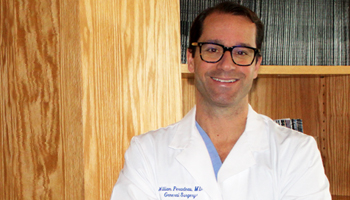HOW CAN WE HELP YOU? Call 1-800-TRY-CHOP
In This Section
New Innovator Award Advances Research in Prenatal Gene Editing to Treat Congenital Disorders

Bill Peranteau, MD, is studying in utero gene editing methods to help find treatments for congenital monogenic disorders.
By Nancy McCann
A New Innovators Award grant is helping a Children’s Hospital of Philadelphia pediatric and fetal surgeon and scientist to advance gene-editing research that could one day allow physicians to correct monogenic diseases before babies are born, in utero, diminishing the devastating effects of the disorders or curing them.
Monogenic diseases, such as cystic fibrosis or spinal muscular atrophy, result from changes in a single gene occurring in all cells of the body. They affect millions of people, globally. Scientists estimate that over 10,000 human diseases result from mutations in a single gene (monogenic), according to the World Health Organization. These diseases, of which some can be diagnosed before birth, are responsible for significant mortality and morbidity after birth. Their chronic nature requires expensive, lifelong medical attention, therapy, and specialist care, which causes a substantial burden on our health care system.
Bill Peranteau, MD, a researcher at CHOP’s Center for Fetal Research, will receive $1.5 million over a five-year period through the New Innovators Award for direct costs to carry out his project “In Utero CRISPR-Mediated Gene Editing to Cure Congenital Monogenic Disorders.” He is focused on monogenic disorders in which the disease process begins before a baby is born, and the disease process is irreversible or causes significant health problems shortly after birth without good therapeutic options currently available.
The NIH Director’s New Innovator Awards are highly competitive and support unusually innovative research by early-career investigators, under the broader umbrella of the High-Risk, High-Rewards Program of the NIH Common Fund. The NIH describes High-Risk, High-Rewards Programs as “unconventional approaches to major challenges in biomedical and behavioral research.”
Why Do In Utero Gene Editing?
The rationale for why you would want to do gene editing before birth is threefold, said Dr. Peranteau, who is also a pediatric and fetal surgeon in CHOP’s Center for Fetal Diagnosis and Treatment:
“First, the fetus is small, enabling you to maximize the dose of gene editing material per weight of the recipient,” Dr. Peranteau said. “Secondly, the target cell populations may be more accessible and more available for editing before birth than after birth. And thirdly, the immune system of the fetus isn’t mature, so immune barriers to gene therapy (gene editing is a form of gene therapy) wouldn’t exist that are currently present after birth and are a limitation of postnatal gene therapy.”
In related research, Dr. Peranteau, an assistant professor of surgery in the Perelman School of Medicine at the University of Pennsylvania, and his team and collaborators at Penn have been successful in delivering gene editing material in mouse models to correct a harmful mutation before birth. By using CRISPR-mediated gene editing, they thwarted a lethal lung disease, surfactant protein deficiency, in which death occurs within hours after birth. This proof-of-concept study, published in Science Translational Medicine, showed that correction of the genetic defect before birth improved lung development and survival in the treated mouse models, demonstrating in utero gene editing could be a promising new approach for treating lung diseases before birth.
“The ability to cure or mitigate a disease via gene editing in mid-to-late gestation before birth and the onset of irreversible pathology is very exciting,” Dr. Peranteau said in a press release at the time of publication. “This is particularly true for diseases that affect the lungs, whose function becomes dramatically more important at the time of birth.”
Digging Deeper
Dr. Peranteau is taking this research to the next level with his current grant, although he emphasizes that much more work needs to be done prior to even thinking about clinical application. He is investigating more clinically relevant delivery mechanisms of gene editing material, such as adeno-associated virus (AAV), and is continuing to evaluate the safety and efficacy of gene editing in animal models.
A key point, of which to be clear, Dr. Peranteau said, is that in utero gene editing is somatic cell gene editing — editing the DNA in specific organs not the germline (genetic material contained in the cellular lineage that can be passed to the next generation).
“What we’re doing is mid-to-late gestation somatic cell gene editing without affecting the germline,” Dr. Peranteau said. “One of our goals is not to edit the germline. In the mouse studies we’ve done, we haven’t seen any germline editing, but that’s one of the points of this grant: We want to make sure, from a safety perspective, that our approach isn’t editing the germline.”